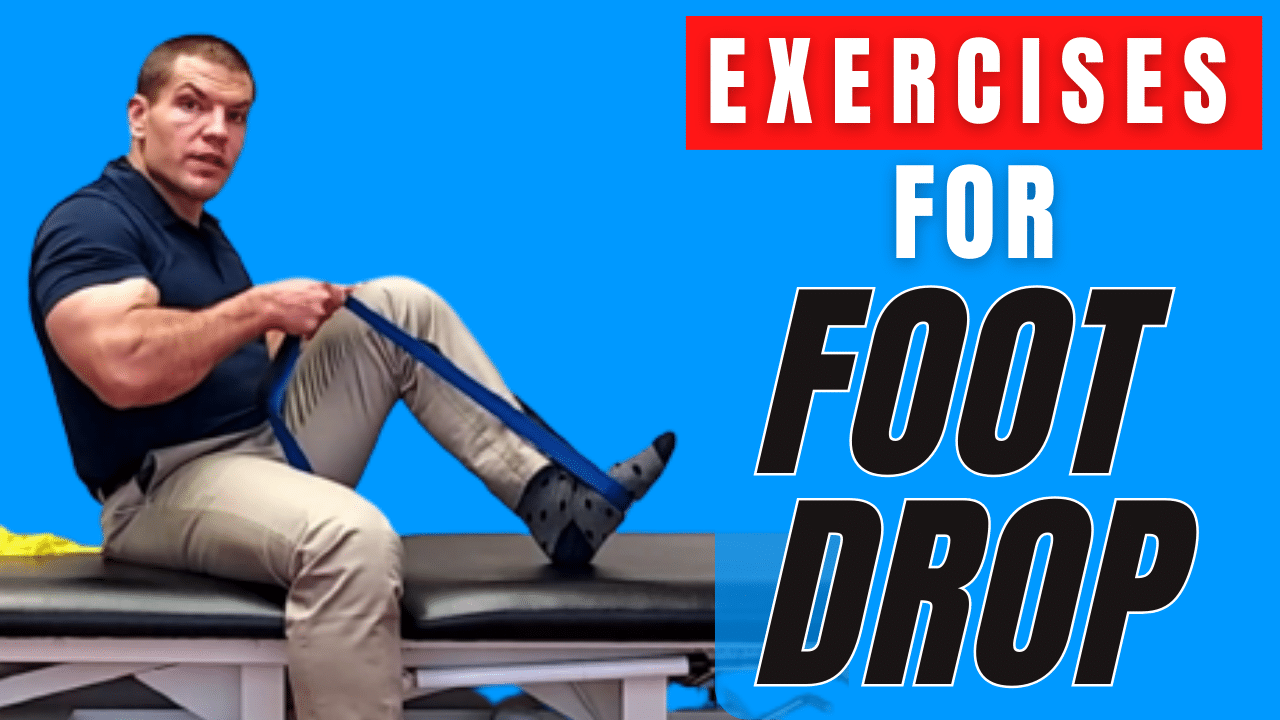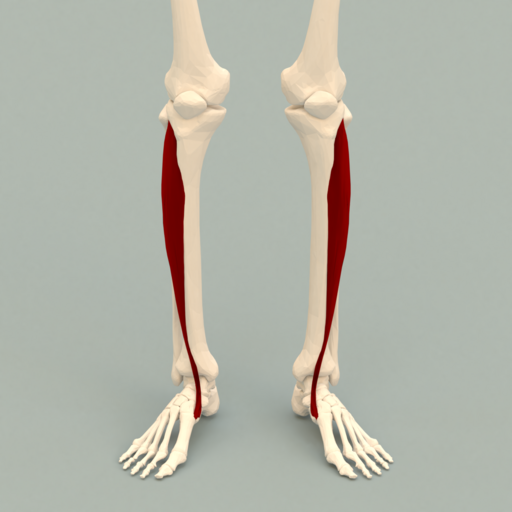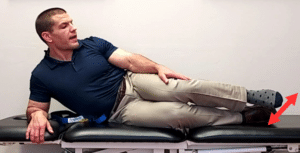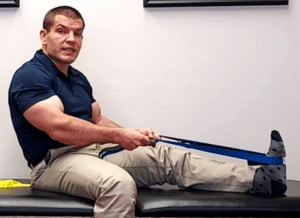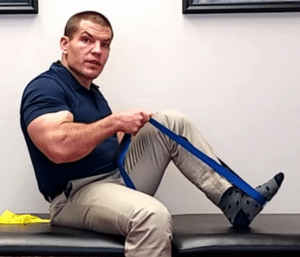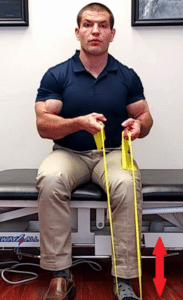If you have drop foot it can give you difficulty walking and put you at risk for a fall. Watch this video to learn exercises for foot drop to help you walk without tripping over your toes.

What Is Foot Drop?
If you're reading this post, chances are you're probably already familiar with what foot drop is.
However, just in case, foot drop is when you're walking and your foot slaps down on the floor when you're walking.
As a milder form, you may have foot drag, where, you have trouble holding your toes up, and so you drag your toes when walking.
Foot Drop Is A Nerve Problem
Foot drop is NOT just a muscle problem in your foot or in your lower leg.
In almost every case, the weakness that gives you trouble holding your foot up is caused by a neurological problem.
That be a central nervous system problem, such as a stroke or multiple sclerosis.
Alternatively, it can be caused by a peripheral nerve problem. For example a pinched nerve in your lower back at the L4 or the L5 nerve roots can cause foot drop.
Those nerves innervate the tibialis anterior muscle, which is the main muscle that helps lift your foot up.
Your toe extensors and your peroneus tertius muscles are also involved. However, the tibialis anterior is the main muscle that lifts your foot up when you're walking so that you don't trip over your toes.
Find The Root Cause Of Foot Drop
So, it is important if you have foot drop to figure out what caused it in the first place. With a nerve injury, the longer that injury goes on, the worse the prognosis gets.
Is There A Cure For Drop Foot?
It really depends on the extent of the nerve injury and how long it's lasted as to if your drop foot can be cured.
When someone has a stroke, they're supposed to go to the hospital right away. That's because the longer it takes before you can get the treatment, the more brain cell death there is.
Similarly, if you have a pinched nerve in your lower back, the longer that nerve is pinched or compressed, the worse the outcome is going to be.
It IS possible to get irreversible nerve damage.
So, it is really important to figure out the issue that's causing the nerve problem and not just do exercises and stretches to get the muscle stronger.
I'll describe exercise for foot drop later in this post. However, just know that they have very little chance of working if you don't address the root cause.
If you still have a central nervous system disorder that's being untreated or you have a peripheral nerve problem that's left untreated, your prognosis is not good.
So, that's the first step in fixing a foot drop.
You need to figure out the cause of the problem and address that first.
Foot Drop From L4-L5 Radiculopathy
Foot drop can from from a pinched nerve in the lower back. Most commonly an L4 or L5 radiculopathy is what causes foot drop.
There are lots of things that can cause the radiculopathy though. Some examples include:
If you have one of those problems, check out the links above more more information on L4-L5 radiculopathy foot drop treatment.
That said, make sure you address the root cause of your foot drop first, or the exercises below likely won't help.
If you live in the St. Louis area and you'd like our help to discover the cause of your foot drop and what you can do to treat it, tap the button below to request a Free Discovery Visit.
Exercises For Foot Drop
As to the exercises that will help foot drop, when you normally think about strengthening a muscle, you think about using weights or resistance bands.
But in the case of foot drop, you have trouble even lifting the foot itself. So just lifting the weight of the foot against gravity is going to be enough resistance in the initial phases.
And in some phases, if the muscle has gotten really, really weak, you may not even be able to lift your foot or lift your toes up against gravity.
Test For Tibialis Anterior Strength
To test and see how much tibialis anterior muscle strength you have, sit in a chair. Then try to lift your foot and your toes up off the floor without lifting your heel.
If you can do that, then you may be able to start doing some strengthening exercises.
However, if you can't even lift the weight of your foot against gravity, then two other resistance sources:
- Gravity
- Your calf muscles
Gravity-Eliminated Foot Drop Exercises
If you can't lift the weight of your foot against gravity, you want to first just make sure you can get some type of active movement or twitch.
In order to eliminate the effect of gravity pushing down, you can lay down on your side and try and move your ankle.
It's easier to move your foot with gravity eliminated. Hopefully you are able to move your foot in this position.
If you can't move your foot in a sidelying position, put your fingers on the outside of your shin and see if you can at least feel a contraction in the tibialis anterior.
If you see movement or at least feel the muscle contract, that's a sign that there's a signal getting from your brain to your muscles. That means that you have at least some capacity to improve.
That's not so say your drop foot will be fully cured, but at least there's a chance for improvement.
If you can't feel ANYTHING happening, there's a chance that the nerve damage may be permanent.
That's not to say that you CAN'T improve, but the, but the odds aren't very good at that point.
So if you can see or feel at least some type of movement in your tibialis anterior, here are started.
Sidelying Ankle Pump Exercise
Lay on your side and move your foot up and down as if stepping on the gas pedal of a car.
Repeat this in sets of 20 repetitions, or as close to that as you can get.
Your actual repetitions will be highly variable based on how much signal the muscle is getting as well as how deconditioned your muscles have gotten.
Once you can successfully perform ankle pumps in sidelying, you're ready to start moving into a seated position.
Calf Stretch Exercises For Foot Drop
You have to also consider that stiffness in your calf muscles.
Your tibialis anterior muscle is an ankle dorsiflexor, meaning it lifts your foot up.
Conversely, your calf muscles are ankle plantarflexors, meaning they point your foot down.
So the stiffer your calves are, the harder your tibialis anterior has to work to overcome the resistance of your calves.
The best way to stretch your calves is standing up. However, if you have foot drop, that may not be the easiest or even the best way for you.
Instead, you can stretch your calves by pulling your foot towards you using a stretching strap or a towel.
RangeMaster Stretch Strap, Multi-loop St...
5% OffYou have two different calf muscles.
The gastrocnemius muscle crosses the knee, and the deeper soleus muscle does not.
Therefore, you want to stretch your calves with your knee straight in order to stretch the gastrocnemius.
You also want to stretch your calves with your knee bent in order to stretch your soleus.
Hold these stretches for about a minutes.
Doing these stretches will help you lengthen your calf muscles so that you're not fighting as much resistance from your own body.
Seated Active-Assistive Exercises For Foot Drop
Once you're able to move your ankle well in sidelying, now it's time to progress to adding back in the gravitational force.
To start out, you may need some assistance to lift your foot against gravity.
You can do this by using a light resistance band (typically yellow in most brands).
Resistance Bands for Working Out, Exerci...
21% OffHowever, in this case, the band isn't so much going to be a resistance band as an assistance band.
In other words, you're going to use the band to help lift your foot.
To do that, you put the band on the ground and pull some tension on it.
Then practice lifting your foot and toes up trying to do as much work using your own strength as you can.
The band is only there to assist you.
The more tension you pull, the easier the exercise gets. The less tension you pull, the harder it gets.
Ideally as you get stronger, you'll use less and less tension on the band. Eventually the goal is to be able to lift your foot against gravity without assistance.
At that point, you're ready to start moving into weightbearing strengthening exercises.
Weightbearing Exercises For Foot Drop
Weightbearing exercises are important if you have drop foot because that's how you use your feet in everyday life.
You use your tibialis anterior to lift your foot up when you're going to take a step.
However, you also use it to help you balance when standing still
Your tibialis anterior pulls your shin bone (tibia) forward toward your feet in order to prevent you from swaying backwards when you're standing up.
So just practicing standing and balancing can be a good strengthening exercise for foot drop.
If you've had some weakness or some foot drop for a while, you're probably used to using AFOs or ankle-foot orthoses.
Doing balance exercises without the orthoses on is a good way to help strengthen your muscles.
It's still a good idea to stand in front of a counter or a couch or another sturdy object just in case you lose your balance.
That's because if your tibialis anterior muscles isn't working, you're more likely to fall backwards. So make sure you're standing by something where you can hold on for safety purposes.
Standing Toe Lift Exercises For Foot Drop
Another weight-bearing strengthening exercise is to lift your toes and the ball of your foot up while standing.
This gets harder to do and is a more advanced exercise for foot drop.
Again, stand by something that you can hold on to for safety so that you don't fall backwards as you're lifting your toes up.
Walking With Toe Lifts
Once you're able to accomplish standing toe lifts, you can turn that into a walking exercise.
Focus on hitting your heel and trying to keep your toes lifted as you walk without letting your toes drag or your foot slap.
If you can do this, the next step would be walking fully on your heels (as an exercise, not when you're actually walking).
If you're able to do that, your foot drop is just about fully cured.
Keep in mind that NOT everyone will be able to fully cure their foot drop.
It's best to start with the easiest exercises on this page, and as you get stronger, gradually progress to more difficult exercises.
Just to be realistic, don't expect this progress to happen quickly.
Nerves injuries recover slowly, and there's no easy way to tell how far along this continuum you'll get. Progress as far as you can until your progress plateaus.
Some cases of foot drop can be cured completely. Some can't.
But MOST can be helped.
As mentioned previously, the sooner you get the proper treatment for your foot drop, the better your chances of recovery is.
Need Help For Foot Drop?
If you need help for foot drop, tap the button below to request an appointment with one of our specialist physical therapists.
Like this post? Here are a few others you might enjoy.
Spinal Stenosis And Walking Problems
Numbness In Fingers? 6 Causes of Tingling In Hands

